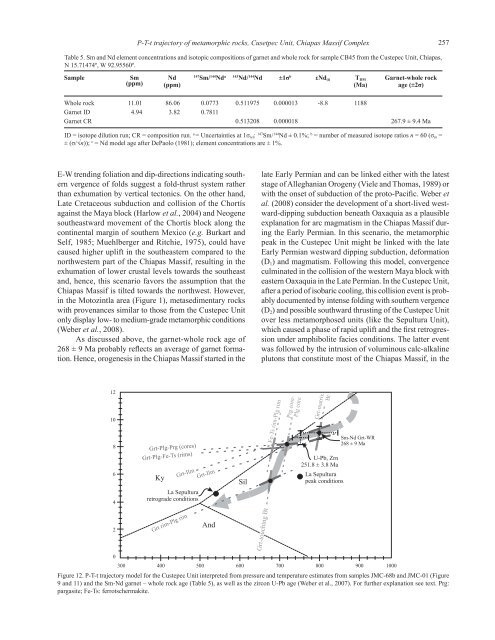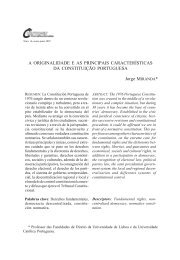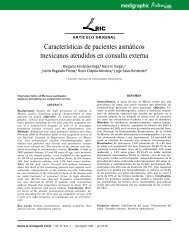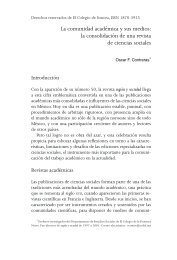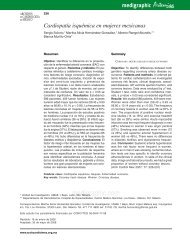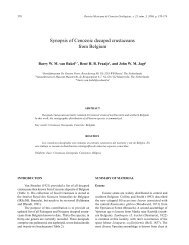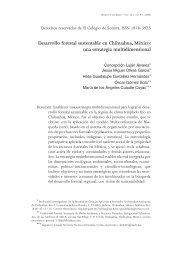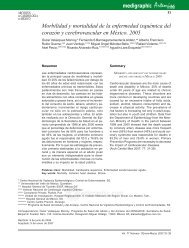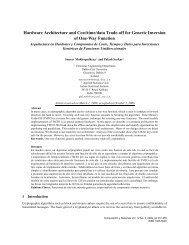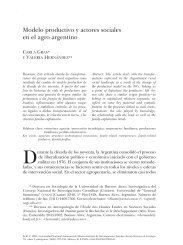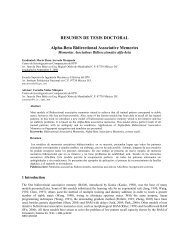P-T-t trajectory of metamorphic rocks from the central ... - SciELO
P-T-t trajectory of metamorphic rocks from the central ... - SciELO
P-T-t trajectory of metamorphic rocks from the central ... - SciELO
You also want an ePaper? Increase the reach of your titles
YUMPU automatically turns print PDFs into web optimized ePapers that Google loves.
P-T-t <strong>trajectory</strong> <strong>of</strong> <strong>metamorphic</strong> <strong>rocks</strong>, Cusetpec Unit, Chiapas Massif Complex 257<br />
Table 5. Sm and Nd element concentrations and isotopic compositions <strong>of</strong> garnet and whole rock for sample CB45 <strong>from</strong> <strong>the</strong> Custepec Unit, Chiapas,<br />
N 15.71474º, W 92.95560º.<br />
Sample<br />
Sm<br />
(ppm)<br />
Nd<br />
(ppm)<br />
147<br />
Sm/ 144 Nd a 143 Nd/ 144 Nd ±1σ b εNd (i) T DM<br />
(Ma)<br />
Garnet-whole rock<br />
age (±2σ)<br />
Whole rock 11.01 86.06 0.0773 0.511975 0.000013 -8.8 1188<br />
Garnet ID 4.94 3.82 0.7811<br />
Garnet CR 0.513208 0.000018 267.9 ± 9.4 Ma<br />
ID = isotope dilution run; CR = composition run. a = Uncertainties at 1σ rel : 147 Sm/ 144 Nd ± 0.1%; b = number <strong>of</strong> measured isotope ratios n = 60 (σ m =<br />
± (σ/√n)); c = Nd model age after DePaolo (1981); element concentrations are ± 1%.<br />
E-W trending foliation and dip-directions indicating sou<strong>the</strong>rn<br />
vergence <strong>of</strong> folds suggest a fold-thrust system ra<strong>the</strong>r<br />
than exhumation by vertical tectonics. On <strong>the</strong> o<strong>the</strong>r hand,<br />
Late Cretaceous subduction and collision <strong>of</strong> <strong>the</strong> Chortís<br />
against <strong>the</strong> Maya block (Harlow et al., 2004) and Neogene<br />
sou<strong>the</strong>astward movement <strong>of</strong> <strong>the</strong> Chortís block along <strong>the</strong><br />
continental margin <strong>of</strong> sou<strong>the</strong>rn Mexico (e.g. Burkart and<br />
Self, 1985; Muehlberger and Ritchie, 1975), could have<br />
caused higher uplift in <strong>the</strong> sou<strong>the</strong>astern compared to <strong>the</strong><br />
northwestern part <strong>of</strong> <strong>the</strong> Chiapas Massif, resulting in <strong>the</strong><br />
exhumation <strong>of</strong> lower crustal levels towards <strong>the</strong> sou<strong>the</strong>ast<br />
and, hence, this scenario favors <strong>the</strong> assumption that <strong>the</strong><br />
Chiapas Massif is tilted towards <strong>the</strong> northwest. However,<br />
in <strong>the</strong> Motozintla area (Figure 1), metasedimentary <strong>rocks</strong><br />
with provenances similar to those <strong>from</strong> <strong>the</strong> Custepec Unit<br />
only display low- to medium-grade <strong>metamorphic</strong> conditions<br />
(Weber et al., 2008).<br />
As discussed above, <strong>the</strong> garnet-whole rock age <strong>of</strong><br />
268 ± 9 Ma probably reflects an average <strong>of</strong> garnet formation.<br />
Hence, orogenesis in <strong>the</strong> Chiapas Massif started in <strong>the</strong><br />
late Early Permian and can be linked ei<strong>the</strong>r with <strong>the</strong> latest<br />
stage <strong>of</strong> Alleghanian Orogeny (Viele and Thomas, 1989) or<br />
with <strong>the</strong> onset <strong>of</strong> subduction <strong>of</strong> <strong>the</strong> proto-Pacific. Weber et<br />
al. (2008) consider <strong>the</strong> development <strong>of</strong> a short-lived westward-dipping<br />
subduction beneath Oaxaquia as a plausible<br />
explanation for arc magmatism in <strong>the</strong> Chiapas Massif during<br />
<strong>the</strong> Early Permian. In this scenario, <strong>the</strong> <strong>metamorphic</strong><br />
peak in <strong>the</strong> Custepec Unit might be linked with <strong>the</strong> late<br />
Early Permian westward dipping subduction, deformation<br />
(D 1 ) and magmatism. Following this model, convergence<br />
culminated in <strong>the</strong> collision <strong>of</strong> <strong>the</strong> western Maya block with<br />
eastern Oaxaquia in <strong>the</strong> Late Permian. In <strong>the</strong> Custepec Unit,<br />
after a period <strong>of</strong> isobaric cooling, this collision event is probably<br />
documented by intense folding with sou<strong>the</strong>rn vergence<br />
(D 2 ) and possible southward thrusting <strong>of</strong> <strong>the</strong> Custepec Unit<br />
over less metamorphosed units (like <strong>the</strong> Sepultura Unit),<br />
which caused a phase <strong>of</strong> rapid uplift and <strong>the</strong> first retrogression<br />
under amphibolite facies conditions. The latter event<br />
was followed by <strong>the</strong> intrusion <strong>of</strong> voluminous calc-alkaline<br />
plutons that constitute most <strong>of</strong> <strong>the</strong> Chiapas Massif, in <strong>the</strong><br />
12<br />
10<br />
8<br />
6<br />
4<br />
Grt-Plg-Prg (cores)<br />
Grt-Plg-Fe-Ts (rims)<br />
Ky<br />
Grt-Ilm<br />
Grt-Ilm<br />
La Sepultura<br />
retrograde conditions<br />
Sil<br />
Fe-Ts rim-Plg rim<br />
Prg core-<br />
Plg core<br />
Grt-matrix<br />
Bt<br />
U-Pb, Zrn<br />
251.8 ± 3.8 Ma<br />
La Sepultura<br />
peak conditions<br />
Sm-Nd Grt-WR<br />
268 ± 9 Ma<br />
2<br />
Grt rim-Plg rim<br />
And<br />
Grt-touching Bt<br />
0<br />
300 400 500 600 700 800 900 1000<br />
Figure 12. P-T-t <strong>trajectory</strong> model for <strong>the</strong> Custepec Unit interpreted <strong>from</strong> pressure and temperature estimates <strong>from</strong> samples JMC-68b and JMC-01 (Figure<br />
9 and 11) and <strong>the</strong> Sm-Nd garnet – whole rock age (Table 5), as well as <strong>the</strong> zircon U-Pb age (Weber et al., 2007). For fur<strong>the</strong>r explanation see text. Prg:<br />
pargasite; Fe-Ts: ferrotschermakite.


